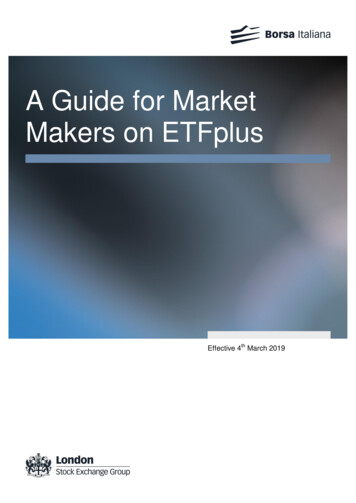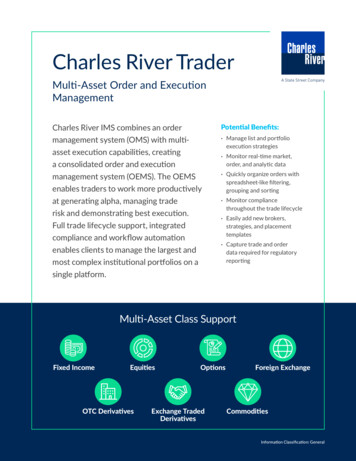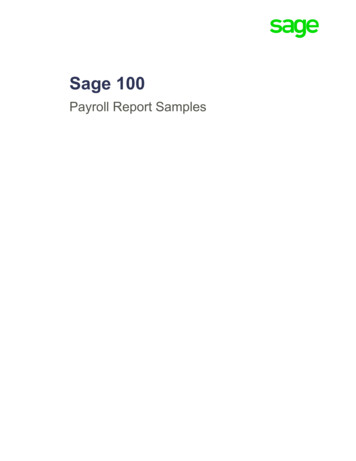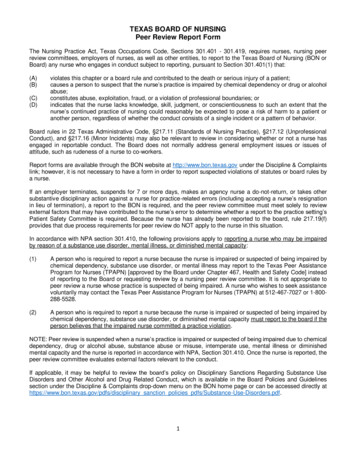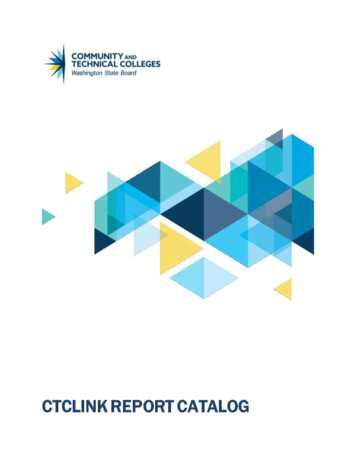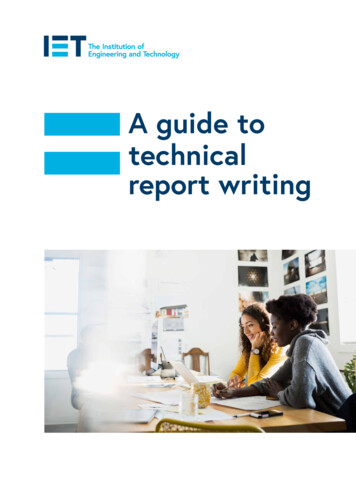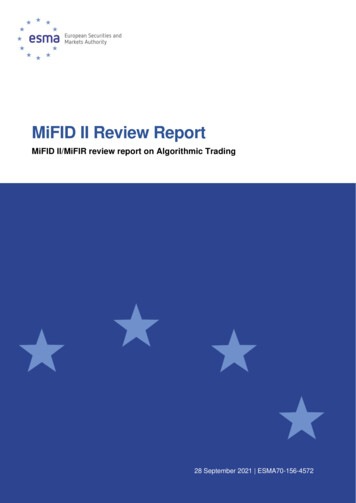
Transcription
MiFID II Review ReportMiFID II/MiFIR review report on Algorithmic Trading28 September 2021 ESMA70-156-4572
Table of contentsExecutive Summary . 8Introduction . 10Overall approach . 113.1Legal framework . 11Algorithmic trading . 11High-frequency trading . 13Direct Electronic Access (DEA) . 133.2Development of algorithmic trading, HFT and DEA . 14Overall assessment . 14State of play of algorithmic trading, HFT and DEA . 16Evolution of algorithmic trading and HFT . 203.3Scope of Algorithmic trading . 21Algorithmic trading and OTC trading . 21Algorithmic trading and DEA users . 233.4High Frequency Trading and high intraday message rates . 24Background. 25Feedback to the consultation . 25ESMA’s assessment and recommendations . 263.5Direct Electronic Access (DEA) . 26Authorisation requirement for persons dealing on own account and having DEAaccess to trading venue . 26Direct Electronic Access and sub-delegation . 29Notification of DEA users to NCAs . 32Direct Electronic Access and On-line Brokerage . 333.6Third-country firms . 34Background. 34Feedback to the consultation . 35ESMA’s assessment and recommendations . 36Organisational requirements for investment firms . 374.1Notifications to NCAs, exchange of information and on-going supervision . 37Background. 37Feedback to the consultation . 38ESMA’s assessment and recommendations . 391
4.2Application RTS 6: algorithmic trading . 40Background. 40Feedback to the consultation . 40ESMA’s assessment and recommendations . 424.3Application RTS 6: testing and testing environment . 42Background. 42Feedback to the consultation . 43ESMA’s assessment and recommendations . 464.4Application RTS 6: annual self-assessment . 47Background. 47Feedback to the consultation . 48ESMA’s assessment and recommendations . 50Organisational requirements for trading venues . 515.1Capacity and Resilience of Trading Venues . 52Background. 52Feedback to the consultation . 53ESMA’s assessment and recommendations . 545.2Testing of algorithms . 55Background. 55Feedback to the consultation . 57ESMA’s assessment and recommendations . 585.3Circuit Breakers . 59Background. 59Feedback to the consultation . 61ESMA’s assessment and recommendations . 625.4Co-location and fee structure . 63Background. 63Feedback to the consultation . 64ESMA’s assessment and recommendations . 655.5Orders to Transactions Ratio (OTR) . 65Background. 65Feedback from the consultation . 66ESMA’s assessment and recommendations . 685.6Monitoring of compliance with trading venues’ rules . 69Background. 692
Feedback to the consultation . 71ESMA’s assessment and recommendations . 74Tick size, market making, asymmetric speedbumps, and trade feeds . 766.1Tick-size regime . 76Tick size regime applicable to shares . 79Tick size regime applicable to third-country shares . 84Tick size regime applicable to ETFs . 88Tick size regime for non-equity instruments . 896.2Market making agreements . 90Background. 90Feedback from the consultation . 92ESMA’s assessment and recommendations . 956.3Speedbumps in Financial Markets . 96Background. 97Feedback from the consultation . 98ESMA’s assessment and recommendations . 1016.4Asymmetry of private and public feeds . 104Background. 104Feedback to the consultation . 106ESMA’s assessment and recommendations . 108Annexes . 1107.1Annex I: Summaries of the responses to the consultation . 1107.2Annex II: Mandate . 1527.3Annex III: List of the proposals made in the Review Report . 1537.4Annex IV: Regime applying to third-country firms . 1567.5Annex V: Template for notifications to NCAs under Article 17(2) and 17(5) of MiFID II1683
Acronyms and definitions usedADNTAverage Daily Number of TransactionsAMFAutorité des Marchés FinanciersCDR (EU) 2017/565Commission Delegated Regulation (EU) 2017/565 of 25 April2016 supplementing Directive 2014/65/EU of the EuropeanParliament and of the Council as regards organisationalrequirements and operating conditions for investment firms anddefined terms for the purposes of that DirectiveCDR (EU) 2019/442Commission Delegated Regulation (EU) 2019/442 of 12December 2018 amending and correcting Delegated Regulation(EU) 2017/587 to specify the requirement for prices to reflectprevailing market conditions and to update and correct certainprovisionsCFTCCommodity Futures Trading CommissionCPConsultation PaperDanish FSADanish Financial Supervisory AuthorityDEADirect Electronic AccessECEuropean CommissionETCExchange Traded CommodityETFExchange Traded FundETNExchange Traded NoteEUEuropean UnionESMAEuropean Securities and Markets AuthorityFBAFrequent Batch AuctionFITRSFinancial Instruments Transparency SystemHFTHigh Frequency TradingIFRInvestment Firm ReviewLMELondon Metal ExchangeMARMarket Abuse Regulation – Regulation (EU) 596/2014 of theEuropean Parliament and of the CouncilMiFID IIMarkets in Financial Instruments Directive (recast) - Directive2014/65 of the European Parliament and of the CouncilMiFIRMarkets in Financial Instruments Regulation – Regulation600/2014 of the European Parliament and of the CouncilMRMTLMost Relevant Market in terms of Liquidity4
MTFMultilateral Trading FacilityNCANational Competent AuthorityOTCOver-the-counterOTFOrganised Trading FacilityOTROrder to Transaction RatioPOPPassive Order ProtectionQ&AQuestion and answerRCBReasonable Commercial BasisRTSRegulatory Technical StandardRTS 1Commission Delegated Regulation (EU) 2017/587 of 14 July ontransparency requirements for trading venues and investmentfirms in respect of shares, depositary receipts, exchange-tradedfunds, certificates and other similar financial instruments and ontransaction execution obligations in respect of certain shares ona trading venue or by a systematic internaliserRTS 6Commission Delegated Regulation (EU) 2017/589 of 19 July2016 on the organisational requirements of investment firmsengaged in algorithmic tradingRTS 7Commission Delegated Regulation (EU) 2017/584 of 14 July2016 supplementing Directive 2014/65/EU of the EuropeanParliament and of the Council with regard to regulatory technicalstandards specifying organisational requirements of tradingvenuesRTS 8Commission Delegated Regulation (EU) 2017/578 of 13 June2016 supplementing Directive 2014/65/EU of the EuropeanParliament and of the Council on markets in financial instrumentswith regard to regulatory technical standards specifying therequirements on market making agreements and schemesRTS 9Commission Delegated Regulation (EU) 2017/566 of 18 May2016 supplementing Directive 2014/65/EU of the EuropeanParliament and of the Council on markets in financial instrumentswith regard to regulatory technical standards for the ratio ofunexecuted orders to transactions in order to prevent disorderlytrading conditionsRTS 10Commission Delegated Regulation (EU) 2017/573 of 6 June2016 supplementing Directive 2014/65/EU of the EuropeanParliament and of the Council on markets in financial instrumentswith regard to regulatory technical standards on requirements toensure fair and non-discriminatory co-location services and feestructuresRTS 11Commission Delegated Regulation (EU) 2017/588 of 14 July2016 supplementing Directive 2014/65/EU of the European5
Parliament and of the Council with regard to regulatory technicalstandards on the tick size regime for shares, depositary receiptsand exchange-traded fundsSECUS Securities and Exchange CommissionSISystematic InternaliserTRV ReportTrends, Risks and Vulnerabilities ReportTVTrading venue6
7
Executive SummaryReasons for publicationDirective 2014/65/EU1 (MiFID II) and Regulation (EU) No 600/20142 (MiFIR) provide for anumber of review reports requiring the European Commission (EC), after consulting ESMA,to report to the European Parliament and the Council on various provisions. This final reportcovers the review provision on the impact of requirements regarding algorithmic tradingincluding high-frequency algorithmic trading set out under Article 90(1)(c) of MiFID II.ContentsMany provisions and requirements of MiFID II relate either directly or indirectly (e.g. directelectronic access or tick sizes) to algorithmic trading. This review report therefore adopts aholistic approach to algorithmic trading and reviews all provisions related directly andindirectly to algorithmic trading with the aim of both simplifying the regime and making itmore efficient.Section 2 provides for an introduction to the report.Section 3 presents cross-cutting topics regarding algorithmic trading and high frequencytrading. ESMA analyses the general provisions relating to algorithmic trading and highfrequency trading and, more specifically, the issues around the concepts of “algorithmictrading”, “Direct Electronic Access”, as well as the authorisation regime for EU and non-EUalgorithmic trading firms deploying their strategies on EU trading venues.Section 4 discusses the organisational requirements for investment firms that engage inalgorithmic trading, including high-frequency traders. It includes more specifically proposalsregarding the notification of algorithmic traders to competent authorities; the testingrequirements and the self-assessment exercises to be performed by investment firms.Section 5 focusses on the organisational requirements for trading venues that enablealgorithmic trading on their systems. The report includes here recommendations andproposals regarding the self-assessment exercises to be performed by trading venues,circuit breakers, the fee structures of trading venues, order to trade ratios as well as marketoutages.Finally, Section 6 addresses the other provisions that aim at better framing the activity ofalgorithmic and high-frequency traders such as tick sizes and market making, while alsodiscussing new issues which have recently emerged on EU markets and are very closelyassociated to algorithmic trading. This includes the deployment of mechanisms calledspeedbumps and the sequence of trade confirmation to individual participants by tradingvenues versus the public disclosure of such transactions.Next Steps8
This report is submitted to the European Commission and is expected to be taken intoconsideration by the European Commission for further legislative proposals on the MiFID II/ MiFIR regime.ESMA stands ready to provide additional technical advice on the legislative amendmentssuggested in the report.1Directive 2014/65/EU of the European Parliament and of the Council of 15 May 2014 on markets in financial instruments andamending Directive 2002/92/EC and Directive 2011/61/EU (OJ L 173, 12.6.2014, p. 349–496).2Regulation (EU) No 600/2014 of the European Parliament and of the Council of 15 May 2014 on markets in financialinstruments and amending Regulation (EU) No 648/2012 (OJ L 173, 12.6.2014, p. 84).9
IntroductionArticle 90 (1)(c) of MiFID II:Before 3 March 2020 the Commission shall, after consulting ESMA, present a report to theEuropean Parliament and the Council on:[ ](c)the impact of requirements regarding algorithmic trading including high-frequencyalgorithmic trading;[ ]1. MiFID II/MiFIR require the European Commission (EC) to present reports to the EuropeanParliament and the Council, after consulting ESMA, on a number of provisions. Article90(1)(c) of MiFID II provides in particular for the submission of a report on “the impact ofrequirements regarding algorithmic trading, including high-frequency algorithmic trading”.2. The MiFID II mandate is therefore not specific regarding which provisions should bereviewed in the concerned report. The concept of algorithmic trading is broad, and manyprovisions of MiFID II are related either explicitly to this type of trading (e.g. Article 17 ofMiFID II) or indirectly (e.g. Direct Electronic Access or tick sizes).3. In this report, ESMA has considered that it was necessary to adopt a holistic approachand to review all relevant provisions together. The report therefore covers (i) the overallapproach towards algorithmic trading and high frequency trading and in particular theauthorisation regime attached to these types of market participants, (ii) the provisionsapplicable to algorithmic and high-frequency traders, (iii) the provisions applicable totrading venues allowing or enabling algorithmic trading through their systems and (iv)other provisions that aim at better framing the activity of algorithmic and high-frequencytraders (e.g. tick size and market making).4. ESMA has also considered it necessary to include analysis of new issues which haverecently emerged in EU markets and that are very closely linked to algorithmic trading,i.e. the recent deployment of mechanisms called speedbumps and the issue about thesequence of publication between (i) the order/trade confirmations sent to individualparticipants and (ii) the public disclosure of orders and transactions.5. Article 90(1)(c) of MiFID II requires the Commission to present its report by 3 March 2020.However, a series of unexpected events have forced ESMA and the Commission toreconsider this deadline. In particular, Brexit and the COVID-19 crisis have not onlyshifted the order of priorities for EU regulators, but this has also forced EU markets toadjust quickly to this new reality making the analysis of the impact of MiFID II morechallenging to undertake in practice.10
6. This report is based on the responses received to the consultation paper that ESMApublished in December 20203. These responses are available for further information onthe ESMA website. The summaries of the responses received are also available in AnnexI.7. Considering the broad scope and complexity of the issues covered in the below report,ESMA has also included in Annex III a table summarising the main proposals.Overall approach8. This section addresses some cross-cutting issues regarding the MiFID II regimeapplicable to firms engaged in algorithmic trading, including high-frequency trading (HFT).It first sets out the legal framework governing this activity in Level 1 and then provides anoverview of firms conducting algorithmic trading, including HFT, in the EU. It furtherdiscusses two issues that have arisen regarding the scope of application of MiFID IIalgorithmic trading and HFT rules in relation to Direct Electronic Access (DEA) and thirdcountry firms. A summary of rules applicable to HFT in some third-country jurisdictions isprovided in Annex IV-C.3.1 Legal framework9. As part of its objective of having more efficient and resilient markets, MiFID II seeks tokeep pace with technological developments and the general electronification of tradingwhich now affect all market segments.10. Whilst recognising the benefit of new trading technologies, MiFID II aims at addressingthe potential risks from increased use of technology, including algorithmic trading, HFTor DEA. As explained in Recital (63) of MiFID II, “Those potential risks from increaseduse of technology are best mitigated by a combination of measures and specific riskcontrols directed at firms that engage in algorithmic trading or high-frequency algorithmictrading techniques, those that provide direct electronic access, and other measuresdirected at operators of trading venues that are accessed by such firms”.Algorithmic trading11. Under Article 4(1)(39) of MiFID II, algorithmic trading is defined as “trading in financialinstruments where a computer algorithm automatically determines individual parametersof orders such as whether to initiate the order, the timing, price or quantity of the order orhow to manage the order after its submission, with limited or no human intervention, anddoes not include any system that is only used for the purpose of routing orders to one ormore trading venues or for the processing of orders involving no determination of any3Consultation Paper on the MiFID II/MiFIR review report on Algorithmic Trading, 18 December 2020, ref. -review-report-algorithmic-trading).11
trading parameters or for the confirmation of orders or the post-trade processing ofexecuted transactions”.12. The definition is further specified in Article 18 of Commission Delegated Regulation (EU)2017/5654 which sets out that “[ ] a system shall be considered as having no or limitedhuman intervention where, for any order or quote generation process or any process tooptimise order-execution, an automated system makes decisions at any of the stages ofinitiating, generating, routing or executing orders or quotes according to pre-determinedparameters”.13. In response to questions from stakeholders, ESMA also issued Q&As5 to clarify the scopeof the computer algorithms captured by the MiFID II definition, notably that the use ofalgorithms which only serve to inform a trader of a particular investment opportunity is notconsidered as algorithmic trading, provided that the execution is not algorithmic.14. An investment firm 6 that uses algorithmic trading is required to comply with specificrequirements to identify and mitigate the risks associated with this type of trading. Thoserequirements include in particular:a. Notification to the NCA of its Home Member State and to the NCAs of the tradingvenues where it deploys its algorithmic trading strategies;b. Provision of information upon request about its trading algorithms, systems andcontrols to the NCA of its Home Member State (this NCA may share this informationwith the NCAs of the trading venues where the investment firm deploys itsstrategies); andc. Compliance with specific organisational requirements, as discussed in section 4.15. Likewise, a trading venue that allows algorithmic trading through its system must complywith specific obligations that are set out in section 5.16. However, and in contrast to HFT, the mere use of algorithmic trading techniques otherthan HFT does not trigger the requirement for that person to be authorised as aninvestment firm.4Commission Delegated Regulation (EU) 2017/565 of 25 April 2016 supplementing Directive 2014/65/EU of the EuropeanParliament and of the Council as regards organisational requirements and operating conditions for investment firms and definedterms for the purposes of that Directive (OJ L 87, 31.3.2017, p. 1–83).5See for instance questions 1 to 3 of section 3 of the MiFID II/MiFIR Q&As on market structure les/library/esma70-872942901-38 qas markets structures issues.pdf).6Those requirements also apply to members or participants of regulated markets and MTFs who are not required to beauthorised under MiFID II pursuant to points (a), (e), (i) and (j) of Article 2(1) as well as to credit institutions authorised underDirective 2013/36/EU pursuant to Article 1(3)(a) of MiFID II.12
High-frequency trading17. High-frequency trading is a subset of algorithmic trading. Article 4(1)(40) of MiFID IIdefines high frequency algorithmic trading technique as “an algorithmic trading techniquecharacterised by:(a) infrastructure intended to minimise network and other types of latencies, includingat least one of the following facilities for algorithmic order entry: co-location, proximityhosting or high-speed direct electronic access;(b) system-determination of order initiation, generation, routing or execution withouthuman intervention for individual trades or orders; and(c) high message intraday rates which constitute orders, quotes or cancellations.”18. Article 19 of Commission Delegated Regulation (EU) 2017/565 further defines a “highmessage intraday rate” as the submission, on average, of any of the following:“(a) at least 2 messages per second with respect to any single financial instrumenttraded on a trading venue;(b) at least 4 messages per second with respect to all financial instruments traded ona trading venue”;where only messages concerning financial instruments for which there is a liquid marketare to be included in the calculation.19. Where a firm is using a high-frequency algorithmic trading technique, the exemption fromauthorisation as an investment firm when only dealing on own account under Article2(1)(d) of MiFID II is no longer available. Nor are the exemptions under Article 2(1)(e) ofMiFID II for operators dealing on own account in emission allowances and Article 2(1)(j)of MiFID II for commodity firms. The required authorisation aims at ensuring that thosefirms are subject to organisational requirements under MiFID II and that they are properlysupervised. Firms that are exempted from MiFID II under points (a), (e), (i) and (j) ofArticle 2(1) of MiFID II and that use algorithmic trading techniques are not required to beauthorised as investment firm but are subject to the measures and controls aiming totackle the specific risks arising from algorithmic trading (Article 1(5) of MiFID II).20. In addition to the requirements applicable to firms engaged in algorithmic trading, firmsusing high-frequency algorithmic trading techniques are subject to specific record keepingrequirements that are discussed in section 4.Direct Electronic Access (DEA)21. A further concept important to note in the context of trading technology is Direct ElectronicAccess (DEA). Under Article 1(41) of MiFID II, DEA refers to “an arrangement where amember or participant or client of a trading venue permits a person to use its trading codeso the person can electronically transmit orders relating to a financial instrument directly13
to the trading venue and includes arrangements which involve the use by a person of theinfrastructure of the member or person or client or any connecting system provided bythe member or participant or client, to transmit the orders (direct market access or DMA)and arrangements where such an infrastructure is not used by a person (sponsoredaccess)”.22. Article 21(4) of Commission Delegated Regulation (EU) 2017/589 7 (RTS 6) furtherintroduces the concept of sub-delegation by referring to: “A DEA provider allowing aDEA client to provide its DEA access to its own clients ('sub-delegation') [ ]”.23. When a person accesses a trading venue using DEA, the exemption from authorisationas investment firm for persons only dealing on own account under Article 2(d) of MiFID IIis no longer available to that person.24. DEA providers must be authorised as investment firms or credit institutions under Article48(7) of MiFID II and cannot operate under the equivalence regime for third-country firms.Furthermore, DEA providers must comply with additional organisational requirements.FIGURE 1: AUTHORISATION REQUIREMENTS FOR DEA USERSSource: ESMA.3.2 Development of algorithmic trading, HFT and DEAOverall assessmentBackground25. Financial markets have significantly evolved over the past decade as a consequence ofnew technologies. Many market participants now make use of algorithmic trading wherea computer algorithm automatically determines aspects of an order with minimal or nohuman intervention and algorithmic trading continues to expand across asset classes7Commission Delegated Regulation (EU) 2017/589 of 19 July 2016 supplementing Directive 2014/65/EU of the EuropeanParliament and of the Council with regard to regulatory technical standards specifying the organisational requirements ofinvestment firms engaged in algorithmic trading (OJ L 77, 20.3.2019, p. 417-448).14
from the more mature equity and interest
trading. ESMA analyses the general provisions relating to algorithmic trading and high-frequency trading and, more specifically, the issues around the concepts of “algorithmic trading”, “Direct Electronic Access”, as well as the authorisation regime for EU and non-EU algorithmic trading firms deploying their s
